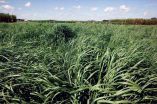Biofuel proteomics
Joint BioEnergy Institute researchers use proteomics to profile switchgrass
2015-03-09
(Press-News.org) If advanced biofuels are to replace gasoline, diesel and jet fuel on a gallon-for-gallon basis at competitive pricing, we're going to need a new generation of fuel crops - plants designed specifically to serve as feedstocks for fuels. Researchers with the U.S. Department of Energy (DOE)'s Joint BioEnergy Institute (JBEI) have demonstrated the power of a new ally in this effort - proteomics!
In a study led by Benjamin Schwessinger, a grass geneticist with JBEI's Feedstocks Division, researchers used advanced proteomic techniques to identify 1,750 unique proteins in shoots of switchgrass (Panicum virgatum), a North American native prairie grass that is widely viewed as one of the most promising of all the fuel crop candidates.
"This was a pilot study to actually test if these proteomic tools are applicable to switchgrass," Schwessinger says. "That we were able to identify such a large number of proteins in our samples shows that proteomics will be useful when we start digging for proteins that will enable us to manipulate switchgrass for increased biofuel production."
The results of this study are reported in the journal Proteomics. The paper is titled "Proteome profile of the endomembrane of developing coleoptiles from switchgrass (Panicum virgatum)." Schwessinger, who also holds an appointment with the University of California Davis, is the corresponding author. JBEI scientist Jeemeng Lao is the lead author. Other co-authors are Manoj Sharma, Rita Sharma, Susana Fernández-Niño, Jeremy Schmutz, Pamela Ronald and Joshua Heazlewood.
The burning of fossil fuels is responsible for the release of nearly 9 billion metric tons of excess carbon into the atmosphere each year. Fuels made from the sugars in plants and other forms of biomass would provide a clean, green and renewable alternative if the production of biofuels is cost-effective. This will require, among other developments, plants whose sugars are more readily extracted and fermented into fuels by microbes.
"Plant cell walls or biomass are costly to deconstruct for sugar release for downstream applications such as biofuels, but genetic modifications to plant cell wall structure could result in significant downstream economic impacts," Schwessinger says.
To this end, Schwessinger and his colleagues carried out the first proteomic analysis of switchgrass material, profiling the proteome of the switchgrass endomembrane from 10-day old dark grown shoots.
"The overall number of unique proteins we identified highlights the contributions proteomics can provide as more plant genomes become publicly accessible," Schwessinger says. "You can think of it as a tool that helps us find needles in a haystack. For example, with proteomics we can determine the four highest expressed members out of a protein family of 60."
INFORMATION:
This research was supported by the DOE Office of Science and the Human Frontier Science Program.
Lawrence Berkeley National Laboratory addresses the world's most urgent scientific challenges by advancing sustainable energy, protecting human health, creating new materials, and revealing the origin and fate of the universe. Founded in 1931, Berkeley Lab's scientific expertise has been recognized with 13 Nobel prizes. The University of California manages Berkeley Lab for the U.S. Department of Energy's Office of Science. For more, visit http://www.lbl.gov.
DOE's Office of Science is the single largest supporter of basic research in the physical sciences in the United States, and is working to address some of the most pressing challenges of our time. For more information, please visit the Office of Science website at science.energy.gov/.
[Attachments] See images for this press release:

ELSE PRESS RELEASES FROM THIS DATE:
2015-03-09
DURHAM, N.C. -- The discovery of the "exercise hormone" irisin three years ago and more than 170 related papers about it since have been called into question by recent research showing they were based on flawed testing kits.
Previous studies suggested that the hormone irisin -- named for the Greek messenger goddess Iris -- travels from muscle to fat tissue after exercise to tell fat cells to start burning energy instead of storing it. The finding ignited hope and press coverage that irisin could hold the key to fighting diabetes and obesity, perhaps one day taking the ...
2015-03-09
In a study that helps to deconstruct how olfaction is encoded in the brain, neuroscientists at University of California, San Diego School of Medicine have identified a type of neuron that appears to help tune, amplify and dampen neuronal responses to chemosensory inputs from the nasal cavity.
The study, published March 9 in Nature Neuroscience, has applications to understanding the root cause of epileptic seizures, which are frequently centered in the olfactory cortex, the part of the brain that processes the sense of smell.
"Our sense of smell is complex and involves ...
2015-03-09
A new class of drugs identified and validated by Mayo Clinic researchers along with collaborators at Scripps Research Institute and others, clearly reduces health problems in mice by limiting the effect of senescent cells -- cells that contribute to frailty and diseases associated with age. The researchers say this is a first step toward developing similar treatments for aging patients. Their findings appear today in the journal Aging Cell.
"If translatable to humans -- which makes sense as we were using human cells in many of the tests - this type of therapy could keep ...
2015-03-09
Irvine, Calif., March 9, 2015 -- Long the stuff of science fiction, the disembodied "brain in a jar" is providing science fact for UC Irvine researchers, who by studying the whole brains of fruit flies are discovering the inner mechanisms of jet lag.
To do this, Todd C. Holmes, professor of physiology & biophysics in the UCI School of Medicine, and colleagues used imaging technology to make movies of fruit fly brains kept alive for six days in a petri dish. The scientists captured the activity of individual circadian clocks at single-cell resolution with an extremely ...
2015-03-09
More than two years after Washington legalized marijuana, parents and teens may be hazy on the specifics of the law, if the findings of a new study are any indication.
University of Washington research, published recently in Substance Use & Misuse, found that only 57 percent of Washington parents surveyed knew the legal age for recreational marijuana use and just 63 percent knew that homegrown marijuana is illegal under the law.
And while 71 percent of 10th-graders correctly identified the legal age, fewer than half (49 percent) knew how much marijuana can legally ...
2015-03-09
MISSOULA - Researchers at the University of Montana, Princeton University, Stanford University and Rutgers University, among others, are collecting new measurements of tropical forests to gain a better understanding of how they respond to seasonal climate variations.
The new information helps predict how the global tropics may react to future climate change. These findings are detailed in a paper titled "Photosynthetic seasonality of global tropical forests constrained by hydroclimate," which was published in Nature Geoscience this month.
"A better understanding ...
2015-03-09
The relationship between human disease and environmental management has been the subject of extensive research, especially given the recent outbreaks of Ebola, SARS and other zoonotic infectious diseases that transmit from animals to humans.
The fieldwork of UC Santa Barbara community ecologist Hillary Young is a good example of researchers' continuing effort to understand exactly how environmental management affects disease emergence. In East Africa, Young examines the direct impacts of human disturbance on landscape and wildlife, as well as a variety of factors affecting ...
2015-03-09
Tropical Cyclone Haliba formed east of the island nation of Madagascar in the Southern Indian Ocean and is now affecting the La Reunion and Mauritius islands. NASA's Terra satellite passed over Haliba on March 9 and captured an image of the storm that showed the eastern quadrant was affecting the two smaller islands.
The Moderate Resolution Imaging Spectroradiometer (MODIS) instrument aboard NASA's Terra satellite captured a visible image of Tropical Cyclone Haliba on March 9 at 06:35 UTC (2:35 a.m. EDT). The image showed both La Reunion and Mauritius islands were covered ...
2015-03-09
Although many people value receiving information about incidental findings identified from genomic sequencing, not everyone wants to know about genetic conditions regardless of potential health implications, found a study of Canadian preferences in CMAJ (Canadian Medical Association Journal).
An incidental finding refers to discovery of a genetic condition that may cause a disease, but the finding is unrelated to why genomic testing was initially ordered by the physician. For example, a test to determine if there is a genetic cause of a patient's colon cancer may find ...
2015-03-09
In a screen of more than 100,000 potential drugs, only one, harmine, drove human insulin-producing beta cells to multiply, according to a study led by researchers at the Icahn School of Medicine at Mount Sinai, funded by JDRF and the National Institutes of Health, and published online today in Nature Medicine.
Diabetes results from too few insulin-producing "beta cells" in the pancreas secreting too little insulin, the hormone required to keep blood sugar levels in the normal range. The disease affects 380 million people worldwide, and leads to major medical complications: ...
LAST 30 PRESS RELEASES:
[Press-News.org] Biofuel proteomics
Joint BioEnergy Institute researchers use proteomics to profile switchgrass


